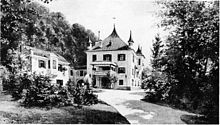Fürberg Castle

The Furberg castle , which is called a wing after the Bavarian family Feyertag of Oberhausen also Feyertagsstöckl, located at the foot of the Kapuzinerberg in Salzburg at the end of Pausingerstraße (no. 11), formerly Fürbergstraße. The property also includes a farm and a medieval chapel, which, like the main building, is decorated with valuable stained glass.
history
As early as 1316, a “Prädium Fürberg”, which was granted to St. Peter's Abbey as a right of inheritance, is mentioned. In 1360 Abbot Otto I and the entire convent of St. Peter conferred the title (estate, property) on the Salzburg citizen Fritz Zchamlin (Zanklein, Zankl). In 1485, the councilor and later mayor Georg Waginger bought the property. In 1500 he was succeeded by his son Virgil (city councilor and mayor of Salzburg). In 1584 the canon Johann von Küenburg and in 1617 the canon Nikolaus Freiherr von Wolkenstein and Rodenegg, Bishop of Chiemsee, became the owners. Wolfgang Feyertag took over ownership of this in 1624. The “Prädium Fürberg”, one of the wings of today's castle, is named Feyertagsstöckel after this family.
Fürberg Castle was first mentioned in a document in 1323. It was built as a castle for a canon, that is, a high-ranking official of the cathedral chapter and the prince-archbishop. In 1490 it is called "Neydeck in Pyrglan circa Imberg " because it was owned by Gregorius Neydeck. He was followed by the royal hunter Ernst von Graben . In 1670 Franz Feyertag von Oberhausen, whose ancestor Wolfgang Feyertag had already acquired the “Prädium Fürberg” next to it in 1624, acquired the Neydeck estate and united the two estates. On the previously existing farmhouse, Franz Feyertag built the castle that stands today, exactly according to the plans of the Flederbach estate, which had become a Fideikommisgut of the Feyertag family through the foundation of the stepbrother and Salzburg mayor Paumann. The Feyertags extended ownership to most of the southeast side of the Kapuzinerberg up to its summit, essentially as the property still represents today. You have ruled and shaped the Fürberg for 250 years. Due to too large inheritance at the end of the 18th century they finally lost their property. The last male descendant of the Feyertags, Kajetan von Feyertag, still kept the Feyertagsstöckl, with which the property was divided again. His unmarried daughter Anna, the last of her name, finally sold this too in 1860.
In 1888, Katharina Wilhelmina von Plason de la Woestyne, b. von Schmieterloew, the property and restores all buildings. It also has a connecting wing between the Stöckl and the castle. Her husband, Adolf Ritter von Plason de la Woestyne, the court and ministerial advisor in the Austro-Hungarian Foreign Ministry, redesigned the building in a neo-renaissance style. A landscape park with very rare trees was created around the castle according to the plans of the architect Lothar Abel and the head gardener Josef Franz. Adolf von Plason gave some of the rare tree species to his friend and patron Archduke Franz Ferdinand for his Konopischt Castle south of Prague. Fürberg Castle is flourishing again under these new owners.
However, it was badly damaged by an air raid by the British on February 17, 1945. The heirs of the Plasons, daughter Mabel, married to Dusan Toncic Edler von Sorinj, and their son Dr. Lujo Toncic Edler von Sorinj rebuild the badly damaged property in the 50s.
The castle has well-preserved towers. The associated chapel is said to date from 1200 and originally represented the end of a Way of the Cross. It was rebuilt three years earlier in 1648 after a fire and renovated in 1893 and 1958. The chapel, as well as the castle, are equipped with high-quality medieval glass paintings.
Fürberg Castle today
A semicircular gate in the surrounding wall leads into the park. A small torrent with a waterfall leads through the park, which contains several outbuildings, a castle chapel and a farm near the castle. The Fürberg farm is already shown in the Franziszeischen land register plan from 1830.
In the course of the Second World War, Fürberg Castle was hit by a bomb and badly damaged. In 1955, a small plane crashed into the Kapuzinerberg and the park of Fürberg Castle. The pilot and three passengers were killed.
The castle is still privately owned and is currently not open to the public.
literature
- Eva Berger : Historic gardens of Austria: Upper Austria, Salzburg, Vorarlberg, Carinthia, Styria, Tyrol. Volume 2, Böhlau, Vienna 2003, ISBN 3-205-99352-7 .
- Peter Walder-Gottsbacher: Nonntal - Inner and Outer Stone in Ancient Views. European Library, Zaltbommel / Netherlands 1996, ISBN 90-288-6349-4 .
- Austrian art topography . Volume XIII: The secular monuments of the city of Salzburg . Vienna 1914, p. 252ff.
- Austrian art topography. Volume XVI: The Art Collections of the City of Salzburg . Vienna 1907, Plason Collection.
Web links
Individual evidence
- ^ Public holiday of Oberhausen In: Communications of the Society for Salzburg Regional Studies. 1930, chap. 12.
- ^ Document dated April 29, 1680, Salzburg
- ↑ Based on a lecture by Lieutenant Colonel of Res. Adolf Frank, Society for Salzburg Regional Studies. February 3, 1924.
- ^ Lujo Tonic-Sorinj: Dreams come true. Croatia. Austria. Europe. Amalthea, Vienna / Munich 1982, ISBN 3-85002-142-4 , p. 23.
- ^ In: Eva Berger: Historical Gardens of Austria: Gardens and parks from the Renaissance to around 1930. Böhlau, Vienna 2002, ISBN 3-205-99477-9 , p. 238. (online at: books.google.at )
- ^ Ernst Bacher: The medieval glass paintings in Salzburg, Tyrol and Vorarlberg. Böhlau, Vienna 2007, ISBN 978-3-205-77653-6 .
Coordinates: 47 ° 48 ′ 13.5 ″ N , 13 ° 3 ′ 45.4 ″ E
